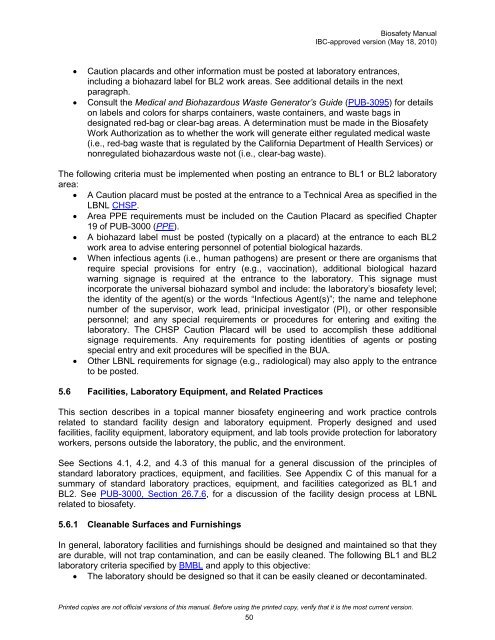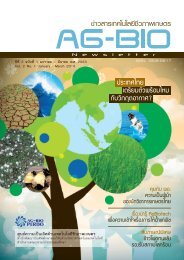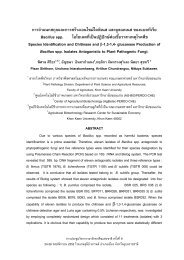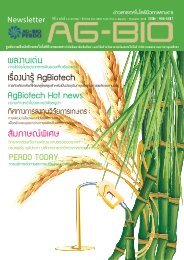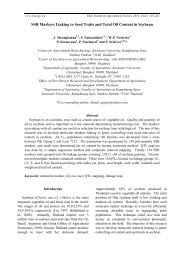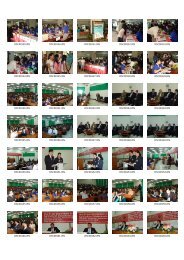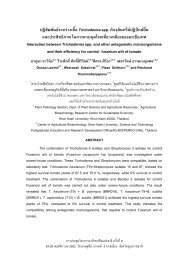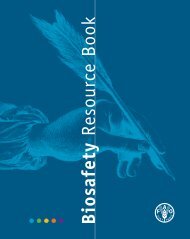Biosafety Manual PDF - Lawrence Berkeley National Laboratory
Biosafety Manual PDF - Lawrence Berkeley National Laboratory
Biosafety Manual PDF - Lawrence Berkeley National Laboratory
Create successful ePaper yourself
Turn your PDF publications into a flip-book with our unique Google optimized e-Paper software.
<strong>Biosafety</strong> <strong>Manual</strong><br />
IBC-approved version (May 18, 2010)<br />
• Caution placards and other information must be posted at laboratory entrances,<br />
including a biohazard label for BL2 work areas. See additional details in the next<br />
paragraph.<br />
• Consult the Medical and Biohazardous Waste Generator’s Guide (PUB-3095) for details<br />
on labels and colors for sharps containers, waste containers, and waste bags in<br />
designated red-bag or clear-bag areas. A determination must be made in the <strong>Biosafety</strong><br />
Work Authorization as to whether the work will generate either regulated medical waste<br />
(i.e., red-bag waste that is regulated by the California Department of Health Services) or<br />
nonregulated biohazardous waste not (i.e., clear-bag waste).<br />
The following criteria must be implemented when posting an entrance to BL1 or BL2 laboratory<br />
area:<br />
• A Caution placard must be posted at the entrance to a Technical Area as specified in the<br />
LBNL CHSP.<br />
• Area PPE requirements must be included on the Caution Placard as specified Chapter<br />
19 of PUB-3000 (PPE).<br />
• A biohazard label must be posted (typically on a placard) at the entrance to each BL2<br />
work area to advise entering personnel of potential biological hazards.<br />
• When infectious agents (i.e., human pathogens) are present or there are organisms that<br />
require special provisions for entry (e.g., vaccination), additional biological hazard<br />
warning signage is required at the entrance to the laboratory. This signage must<br />
incorporate the universal biohazard symbol and include: the laboratory’s biosafety level;<br />
the identity of the agent(s) or the words “Infectious Agent(s)”; the name and telephone<br />
number of the supervisor, work lead, prinicipal investigator (PI), or other responsible<br />
personnel; and any special requirements or procedures for entering and exiting the<br />
laboratory. The CHSP Caution Placard will be used to accomplish these additional<br />
signage requirements. Any requirements for posting identities of agents or posting<br />
special entry and exit procedures will be specified in the BUA.<br />
• Other LBNL requirements for signage (e.g., radiological) may also apply to the entrance<br />
to be posted.<br />
5.6 Facilities, <strong>Laboratory</strong> Equipment, and Related Practices<br />
This section describes in a topical manner biosafety engineering and work practice controls<br />
related to standard facility design and laboratory equipment. Properly designed and used<br />
facilities, facility equipment, laboratory equipment, and lab tools provide protection for laboratory<br />
workers, persons outside the laboratory, the public, and the environment.<br />
See Sections 4.1, 4.2, and 4.3 of this manual for a general discussion of the principles of<br />
standard laboratory practices, equipment, and facilities. See Appendix C of this manual for a<br />
summary of standard laboratory practices, equipment, and facilities categorized as BL1 and<br />
BL2. See PUB-3000, Section 26.7.6, for a discussion of the facility design process at LBNL<br />
related to biosafety.<br />
5.6.1 Cleanable Surfaces and Furnishings<br />
In general, laboratory facilities and furnishings should be designed and maintained so that they<br />
are durable, will not trap contamination, and can be easily cleaned. The following BL1 and BL2<br />
laboratory criteria specified by BMBL and apply to this objective:<br />
• The laboratory should be designed so that it can be easily cleaned or decontaminated.<br />
Printed copies are not official versions of this manual. Before using the printed copy, verify that it is the most current version.<br />
50


